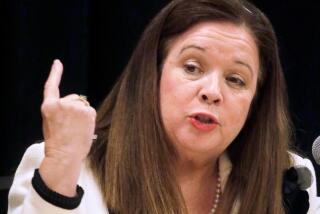Critics Cry Foul Over Airline Fuel Surcharges
- Share via
The next time you buy an airline ticket, look twice at the price.
Earlier this month, while increasing their domestic round-trip fares by $20 in a single stroke, several of the largest carriers began computing fares in a new way.
By press time on Thursday, federal authorities were questioning the unusual way in which the carriers imposed it. With some lines defending the new strategy (including American) and at least one rejecting it (Southwest), it’s unclear how the dust will settle. But if any airline succeeds in adopting this new price-hike strategy, several consumer advocates say, this could mark a new era in deceptive pricing.
The airlines, meanwhile, say they’re just trying to explain themselves, letting consumers know that tickets cost more because the price of fuel has increased.
The lesson for consumers: Always base your decisions on prices that include all taxes, fees and surcharges--many of which may be missing when you hear the first price quote.
At issue are “fuel surcharges,” an idea introduced Jan. 19 by Continental Airlines. Instead of increasing prices in the usual way, Continental announced a “fuel surcharge” of $20 per round trip on domestic travel, beginning Tuesday.
This surcharge may be excluded from the rate quotes that pop up first on travel agents’ computer reservations systems used to compare rates. Instead, it may show up after the booking is made, along with airport facilities fees and other government levies. (A Continental spokeswoman said the surcharge is included in initial fare quotes offered by the airlines’ Internet site and telephone operators.)
By inventing this categorization, Continental kept its price increase invisible, and it excluded the new income from commission payments to travel agencies and from discount agreements with corporate business-travel customers.
Ed Perkins, ombudsman for the American Society of Travel Agents and longtime airline industry watchdog, immediately howled with outrage. By setting apart that $20 in expenses and attaching the word “surcharge,” some airlines were creating the impression that this price increase is a government action, Perkins asserted, when these are simply businesses choosing to increase prices. (From the $20 surcharge, $18.60 goes into airline coffers and $1.40 to federal taxes.)
The idea might have died--as many price increases do--if other airlines left Continental standing alone in this new territory. Instead, American and United soon joined Continental, with the same effective date. Then came Delta (which made its price increase effective immediately) and Northwest and US Airways. By Jan. 25, each of the 10 major carriers had adopted some version of the fare increase. Southwest was the most restrained; it increased prices $4 to $8 per round trip without employing any surcharge language. “A fare increase is a fare increase,” said spokesman Ed Stewart.
On computerized fare quotes to travel agents and on their Internet sites, air fare experts said, most of those carriers were lumping the $20 price increase in with taxes, instead of including it in their core price.
The Department of Transportation, which monitors air fares, at first did nothing. But in following days, a spokesman said, it reminded carriers that only governmental fees should be excluded from price quotes. After that, some carriers, including United, seemed to be backing away from their initial position. Others, including American, said Thursday that they would continue to use the new pricing strategy.
This game is still being played out. So if you need to book a ticket, ask whether the ticket reflects a new fuel surcharge.
Under federal law, airline ads and fare quotes “must cite the full price to be paid, except that they can list separately governmentally imposed charges,” said Bill Mosley, a spokesman for the U.S. Department of Transportation. “But this is something the airlines themselves are imposing. So in terms of it appearing [in an advertisement or on a travel agent’s computer screen], they would need to incorporate the surcharge into the price.”
“We may have a new animal here,” said Terry Trippler, an in-house air fare expert for the Internet site 1travel.com. “This is a dangerous precedent. If you want to raise air fares, raise them. But this is clearly not being straight with the consumer. It doesn’t appear in the fare displays. It’s time for our do-nothing Department of Transportation to do something.”
At the Consumer Reports Travel Letter, editor Laurie Berger suggested that some of the airlines are calling this a fuel surcharge “because they have been so unsuccessful at making fare increases stick” in recent months.
“And $20?” she added. “That’s a lot.”
Fuel costs have climbed. Since February 1999, crude oil rates have reached their highest levels since the 1991 Gulf War and were the principal cause cited when major airlines reported lower earnings in the fourth quarter of 1999.
Still, this surcharge is a strange beast. It’s $20 for a round trip, regardless of whether the flight is between LAX and San Francisco or between LAX and New York . Also, the airlines have left their international fares alone.
Los Angeles Times corporate travel agent Andrea Bushnell and I tried a few test bookings Jan. 20. When we punched in a round-trip Continental ticket between LAX and Newark (leaving LAX on Feb. 22, returning Feb. 24), the computer gave us a quote of $2,056. When we made the booking, the system added $11 more in airport taxes--and the new fuel surcharge of $9.30 on each flight, with 70 cents of federal taxes on top of that. Thus a $2,056 fare grew to $2,087.
“It’s ridiculous,” said ASTA’s Perkins. “The next time the pilots negotiate a raise, do we get a salary surcharge?”
*
If you want to register an opinion on the surcharge, the U.S. Department of Transportation takes public input by phone at (202) 366-2220 and by e-mail at airconsumer@ost.dot.gov.
Christopher Reynolds welcomes comments and suggestions, but cannot respond individually to letters and calls. Write Travel Insider, Los Angeles Times, Times Mirror Square, Los Angeles 90053, or send e-mail to chris.reynolds@latimes.com.



